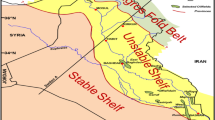Abstract
Nowadays, the oil and gas exploration and development have been developed into the deep and complex formations. More and more abnormal pressure is encountered, which gives a great challenge to the safe and efficient drilling. Accurate description of pore pressure is of great significance to avoid drilling risk. The complexity of petroleum geology, the incompleteness of the logging or seismic data, the precision of the mathematical model and other issues can all lead to uncertainty in pore pressure prediction. The uncertainty of pore pressure is one of the fundamental causes for drilling risk. In order to address these challenges, a new quantitative description method for uncertainty of pore pressure was established. Firstly the sources of the pore pressure prediction uncertainty were analyzed. Then the uncertainties of Eaton index and normal compaction trend were, respectively, described. Finally the uncertainty interval of pore pressure was established based on Monte–Carlo simulation and normal information diffusion theory. The pore pressure prediction result obtained in this paper was not a single value, but an interval with probability distribution characteristic. The results of example showed that the measured values of pore pressure were all in pore pressure interval with confidence of 90%. Case study validated the feasibility and effectiveness of the proposed method.
Similar content being viewed by others
References
Bratton, T.; Edwards, S.; Fuller, J.; et al.: Avoiding drilling problems. Oilfield Rev. 13(2), 211–213 (2001)
Belonin, M.D.; Slavin, V.I.; Chilingar, G.V.; et al.: Exploration and exploitation in oil and gas fields with abnormally high formation pressures. Energy Sour. 25(1), 43–55 (2003)
Konyashkin, A.V.; Doronkin, A.V.; Tyrtyshnyy, V.A.; et al.: Application of formation pressure prediction technology to drilling in junggar basin. Nat. Gas Ind. 29(8), 2045–2048 (2009)
Austin, E.H.: Drilling Engineering Handbook. International Human Resources Development Corp, Boston (1983)
Jin, Y.; Wang, Y.; Li, Z.: Undercompaction causes for using seismic data to predict formation pore pressure. Pet. Drill. Tech. 03(1), 7–9 (2000)
Sayers, C.M.; Johnson, G.M.; Denyer, G.: Predrill pore-pressure prediction using seismic data. Geophysics 67(4), 1286 (2000)
López, J.L.; Rappold, P.M.; Ugueto, G.A.; et al.: Integrated shared earth model: 3D pore-pressure prediction and uncertainty analysis. Lead. Edge 23(1), 52–59 (2004)
Moon, T.: SPE/AAPG/SEG workshop addresses pore-pressure uncertainties. Lead. Edge 26(8), 74–79 (2012)
Falcao, J.L.: Uncertainties in the Pore Pressure Evaluation in Deepwater: A Statistical Approach. SPE 78247 (2002)
Sayers, C.M.; Boer, L.D.D.; Nagy, Z.R.; et al.: Well-constrained seismic estimation of pore-pressure with uncertainty. Seg Tech. Prog. Expand. Abstr. 25(1), 1530–1532 (2006)
Liang, Q.J.: Application of quantitative risk analysis to pore pressure and fracture gradient prediction. Society of Petroleum Engineers, SPE 77354 (2002)
Alberto M.; Sayers C.M.; Woodward, M.J., et al.: Integrating diverse measurements to predict pore pressure with uncertainties while drilling. SPE 90001 (2004)
Moos D.; Peska P.; Ward C.; et al.: Quantitative risk assessment applied to pre-drill pore pressure, sealing potential, and mud window predictions from seismic data. In: Gulf Rocks E North America Rock Mechanics Symposium (2004)
Doyen P.M.; Malinverno A,; Prioul R., et al.: Seismic pore-pressure prediction with uncertainty using a probabilistic mechanical earth model. Seg Tech. Progr. Expand. 22(1), 1366–1375 (2003)
Wessling, S.; Bartetzko, A.; Tesch, P.: Quantification of uncertainty in a multistage/multiparameter modeling workflow: pore-pressure from geophysical well logs. Geophysics 78(3), 101–112 (2013)
Zhang, J.: Effective stress, porosity, velocity and abnormal pore-pressure prediction accounting for compaction disequilibrium and unloading. Mar. Pet. Geol. 45(4), 2–11 (2013)
Pennebaker, E.S.J.R.: Seismic data depth magnitude of abnormal pressure. World Oil 20(3), 73–77 (1968)
Fillippone W.R.: Prediction of abnormally pressured sedimentary rocks from seismic data. OTC (1979)
Fillippone W.R.: Estimation of formation parameters and the prediction of overpressures from seismic data. SEG-1982-0502 (1982).
Eaton B.A.: The equation for geopressure prediction from well logs. SPE 5544 (1975)
Bowers, G.L.: Pore-pressure estimation from velocity data: accounting for overpressure mechanisms besides undercompaction. Int. J. Rock Mech. Min. Sci. Geomech. Abstr. 10(2), 89–95 (1995)
Honghai, Fan: A simple pore-pressure estimation method for a disequilibrium compaction shale using sonic velocity. Pet. Drill. Tech. 29(5), 9–11 (2001)
Wang, J.S.: Efficient Monte Carlo Simulation Methods in Statistical Physics. Monte Carlo and Quasi-Monte Carlo Methods, vol. 2000, pp. 141–157. Springer, Berlin (2001)
Fisz, M.: Probability theory and mathematical statistics. Technometrics 6(4), 333–340 (1963)
Gong, F.; Hou, S.; Yan, X.: Probability model deduction method of Mohr–Coulomb criteria parameters based on normal information diffusion principle. Yanshilixue Yu Gongcheng Xuebao/Chinese J. Rock Mech. Eng. 32(11), 2225–2234 (2013)
Author information
Authors and Affiliations
Corresponding author
Rights and permissions
About this article
Cite this article
Sheng, YN., Guan, ZC. & Xu, YQ. Quantitative Description Method for Uncertainty of Formation Pore Pressure. Arab J Sci Eng 43, 2605–2613 (2018). https://doi.org/10.1007/s13369-017-2863-x
Received:
Accepted:
Published:
Issue Date:
DOI: https://doi.org/10.1007/s13369-017-2863-x




